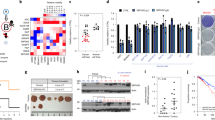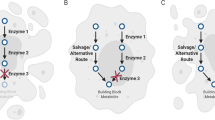Abstract
Selenium compounds have a long history in chemoprevention of mammary and colon cancers in rodent models. Selenium compounds are in current clinical trials, having shown promise in prevention of prostate and other human cancers. In human tissues, it has been estimated that each cell sustains approximately 10 000 potentially mutagenic (if not repaired) lesions per day due to endogenous DNA damage. Almost no studies have addressed the potential for selenium compounds to induce DNA repair, a potential mechanism for their cancer-preventive actions. We show that selenium in the form of selenomethionine induces a DNA repair response in normal human fibroblasts in vitro, and protects cells from DNA damage. We show a possible mechanism for the inducible DNA repair response, in which enhanced repair complex formation was observed in selenomethionine-treated cells.
This is a preview of subscription content, access via your institution
Access options
Subscribe to this journal
Receive 50 print issues and online access
$259.00 per year
only $5.18 per issue
Buy this article
- Purchase on Springer Link
- Instant access to full article PDF
Prices may be subject to local taxes which are calculated during checkout





Similar content being viewed by others
Abbreviations
- UV:
-
ultraviolet radiation
- SeMet:
-
selenomethionine
- XP:
-
xeroderma pigmentosum
References
Aboussekhra A, Wood RD . 1995 Exp. Cell Res. 221: 326–332
Allan CB, Lacourciere GM, Stadtman TC . 1999 Annu. Rev. Nutr. 19: 1–16
Ames B, Gold LS . 1997 Environ. Health Perspect. 105: (suppl. 14) 865–873
Baines AT, Holubec H, Basye JL, Thorne P, Bhattacharyya AK, Spallholz J, Shriver B, Cui H, Roe D, Clark LC, Earnest DL, Nelson MA . 2000 Cancer Lett. 160: 193–198
Berggren M, Mangin JF, Gasdaski JR, Powis G . 1999 Biochem. Pharmacol. 57: 187–193
Cheo DL, Burns DK, Meira LB, Houle JF, Friedberg EC . 1999 Cancer Res. 59: 771–775
Clark LC, Combs GF, Turnbull BW, Slate EH, Chalker DK, Chow J, Davis LS, Glover RA, Graham GF, Gross EG, Krongrad A, Lesher JL, Park HK, Sanders BB, Smith CL, Taylor JR . 1996 J. Am. Med. Assoc. 276: 1957–1963
Collins AR, Ma A-G, Duthie SJ . 1995 Mut. Res. 336: 69–77
Combs GF . 1997 Biomed. Environ. Sci. 10: 356–358
Doetsch PW, Zasatawny TH, Martin AM, Dizdaroglu M . 1995 Biochemistry 34: 737–742
Ganesan AK, Hunt J, Hanawalt PC . 1999 Mutat. Res. 433: 117–126
Ganther HE . 1999 Carcinogenesis 20: 1657–1666
Gary R, Kim K, Cornelius HL, Park MS, Matsumoto Y . 1999 J. Biol. Chem. 274: 4354–4363
Gniadecki R, Thorn T, Vicanova J, Petersen A, Wulf HC . 2000 J. Cell Biochem. 80: 216–222
Grossman L . 1997 Environ. Health Perspect. 105: 927–930
He Z, Ingles CJ . 1997 Nucleic Acids Res. 25: 1136–1141
Ip C . 1981 Cancer Res. 41: 4386–4390
Ip C, Lisk DJ . 1994 Nutr. Cancer 21: 203–212
Ip C, el-Bayoumi K, Upadhyaya P, Ganther H, Vadhanavikit S, Thompson H . 1994a Carcinogenesis 15: 187–192
Ip C, Thompson H, Ganther H . 1994b Carcinogenesis 15: 2879–2882
Ip C, Thompson HJ, Ganther HE . 1998 Anticancer Res. 18: 9–12
Ip C, Zhu Z, Thompson HJ, Lisk D, Ganther HE . 1999 Anticancer Res. 19: 2875–2880
Karmakar P, Balajee AS, Natarajan AT . 2001 Mutagenesis 16: 225–232
Lindahl T, Wood RD . 1999 Science 286: 1897–1905
Lu J, Jiang C, Kaeck M, Ganther H, Vadhanavikit S, Ip C, Thompson HJ . 1995 Biochem. Pharmacol. 50: 213–219
Morris EJ, Dreixler JC, Cheng CY, Wilson PM, Gin RM, Geller HM . 1998 Biotechniques 26: 282–289
Nelson MA, Porterfield BW, Jacobs ET, Clark LC . 1999 Semin. Urol. Oncol. 17: 91–96
Parshad R, Price FM, Bohr VA, Cowan KH, Zujewski JA, Sanford K . 1996 Br. J. Cancer 74: 1–5
Patterson BH, Levander OA . 1997 Cancer Epidemiol. Biomarkers Prev. 6: 63–69
Redman C, Scott JA, Baines AT, Basye JL, Clark LC, Calley C, Payne CM, Nelson MA . 1998 Cancer Lett. 125: 103–110
Saito MS, Jones CJ, Wood RD, Lindahl T . 1993 Proc. Natl. Acad. Sci. USA 90: 6335–6339
Seo YR, Fishel ML, Amundson SA, Kelley MR, Smith ML . 2002 Oncogene 21: 731–737
Sinha R, Said TK, Medina D . 1996 Cancer Lett. 107: 277–284
Smith ML, Chen IT, Zhan Q, Bae I, Chen CY, Gilmer TM, Kastan MB, O'Connor PM, Fornace Jr AJ . 1994 Science 266: 1376–1380
Smith ML, Chen IT, Zhan Q, O'Connor PM, Fornace Jr AJ . 1995 Oncogene 10: 1053–1059
Smith ML, Ford JM, Hollander MC, Bortnick RA, Amundson SA, Seo YR, Deng C, Hanawalt PC, Fornace Jr AJ . 2000 Mol. Cell Biol. 20: 3705–3714
Stewart MS, Spallholtz JE, Nelder KH, Pence BC . 1999 Free Radic. Biol. Med. 26: 42–48
Stucki M, Pascucci B, Parlanti E, Fortini P, Wilson SH, Hubscher U, Dogliotti E . 1998 Oncogene 17: 835–843
Acknowledgements
This work was supported by American Cancer Society RSG-02-028-01 CNE to ML Smith and by Indiana University Cancer Center.
Author information
Authors and Affiliations
Corresponding author
Rights and permissions
About this article
Cite this article
Seo, Y., Sweeney, C. & Smith, M. Selenomethionine induction of DNA repair response in human fibroblasts. Oncogene 21, 3663–3669 (2002). https://doi.org/10.1038/sj.onc.1205468
Received:
Revised:
Accepted:
Published:
Issue Date:
DOI: https://doi.org/10.1038/sj.onc.1205468
Keywords
This article is cited by
-
The role of selenium metabolism and selenoproteins in cartilage homeostasis and arthropathies
Experimental & Molecular Medicine (2020)
-
Comparative Safety and Pharmacokinetic Evaluation of Three Oral Selenium Compounds in Cancer Patients
Biological Trace Element Research (2019)
-
Effect of Low-Dose Selenium Supplementation on the Genotoxicity, Tissue Injury and Survival of Mice Exposed to Acute Whole-Body Irradiation
Biological Trace Element Research (2017)
-
Gene expression profiling reveals differential effects of sodium selenite, selenomethionine, and yeast-derived selenium in the mouse
Genes & Nutrition (2012)
-
Serum levels of selenium and smoking habits at age 50 influence long term prostate cancer risk; a 34 year ULSAM follow-up
BMC Cancer (2011)



